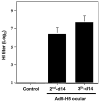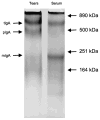Induction of mucosal immunity in the avian Harderian gland with a replication-deficient Ad5 vector expressing avian influenza H5 hemagglutinin
- PMID: 18773917
- PMCID: PMC2931278
- DOI: 10.1016/j.dci.2008.07.018
Induction of mucosal immunity in the avian Harderian gland with a replication-deficient Ad5 vector expressing avian influenza H5 hemagglutinin
Abstract
The chicken Harderian gland (HG) plays an important role in adaptive immune responses upon ocular exposure to avian pathogens such as avian influenza (AI). To determine the role of HGs in generating immunity, chickens were immunized ocularly with an adenovirus (Ad5) vector expressing the AI hemagglutinin H5 gene. The Ad5-H5 vector induced H5 transgene expression and induced H5- and Ad5-specific IgA and IgG spot-forming cells (SFCs) in the HGs. The IgA and IgG SFC peaked on day 9 forAd5 and day 11 for the H5 protein. In addition, Ad5- and H5-specific antibodies were induced in serum. IgA in chicken tears was predominantly dimeric, while in serum monomeric IgA was most abundant. Analysis of HG mRNA confirmed expression of the polymeric immunoglobulin receptor (plgR). These data demonstrated the importance of HGs to generate mucosal and systemic immunity to AI following ocular Ad5-H5 administration to chickens.
Figures








Similar articles
-
Protection of chickens against avian influenza with non-replicating adenovirus-vectored vaccine.Vaccine. 2008 May 19;26(21):2640-6. doi: 10.1016/j.vaccine.2008.02.056. Epub 2008 Mar 17. Vaccine. 2008. PMID: 18384919 Free PMC article.
-
Protection of chickens against avian influenza with nonreplicating adenovirus-vectored vaccine.Poult Sci. 2009 Apr;88(4):867-71. doi: 10.3382/ps.2008-00333. Poult Sci. 2009. PMID: 19276437
-
Protection of chickens against H5N1 highly pathogenic avian influenza virus infection by live vaccination with infectious laryngotracheitis virus recombinants expressing H5 hemagglutinin and N1 neuraminidase.Vaccine. 2009 Jan 29;27(5):773-85. doi: 10.1016/j.vaccine.2008.11.033. Epub 2008 Nov 28. Vaccine. 2009. PMID: 19041677
-
Development and use of fowlpox vectored vaccines for avian influenza.Ann N Y Acad Sci. 2006 Oct;1081:193-201. doi: 10.1196/annals.1373.023. Ann N Y Acad Sci. 2006. PMID: 17135511 Review.
-
Innovation in Newcastle Disease Virus Vectored Avian Influenza Vaccines.Viruses. 2019 Mar 26;11(3):300. doi: 10.3390/v11030300. Viruses. 2019. PMID: 30917500 Free PMC article. Review.
Cited by
-
Immune Evaluation of Avian Influenza Virus HAr Protein Expressed in Dunaliella salina in the Mucosa of Chicken.Vaccines (Basel). 2022 Aug 29;10(9):1418. doi: 10.3390/vaccines10091418. Vaccines (Basel). 2022. PMID: 36146496 Free PMC article.
-
Avian influenza vaccination in chickens and pigs with replication-competent adenovirus-free human recombinant adenovirus 5.Avian Dis. 2010 Mar;54(1 Suppl):224-31. doi: 10.1637/8773-033109-Reg.1. Avian Dis. 2010. PMID: 20521636 Free PMC article.
-
Immune Responses in the Eye-Associated Lymphoid Tissues of Chickens after Ocular Inoculation with Vaccine and Virulent Strains of the Respiratory Infectious Laryngotracheitis Virus (ILTV).Viruses. 2019 Jul 10;11(7):635. doi: 10.3390/v11070635. Viruses. 2019. PMID: 31295877 Free PMC article.
-
Identification of the T-box transcription factor t-bet in chickens and its role in immune response.Poult Sci. 2025 Jul 19;104(10):105589. doi: 10.1016/j.psj.2025.105589. Online ahead of print. Poult Sci. 2025. PMID: 40737904 Free PMC article.
-
Comparative Safety, Immunogenicity, and Efficacy of CEF Cell-Based and DF-1 Cell Line Adapted Infectious Bursal Disease Vaccines in Specific-Pathogen-Free Chickens.J Immunol Res. 2022 Oct 15;2022:5392033. doi: 10.1155/2022/5392033. eCollection 2022. J Immunol Res. 2022. PMID: 36285182 Free PMC article.
References
Publication types
MeSH terms
Substances
Grants and funding
LinkOut - more resources
Full Text Sources
Other Literature Sources
Medical
Miscellaneous

